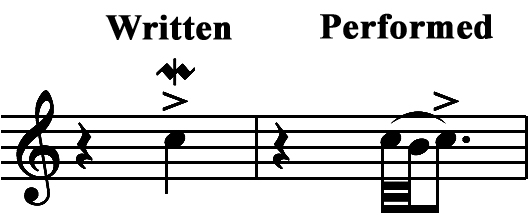inverted mordent
[English]
An ornament that consists of at least two grace notes that are performed before the main note. It is typically performed with the first grace note being the main note followed by a second grace note immediately below the main note and ending on the main note. The notation is the same symbol as the mordent with a short vertical line bisecting it. The mordent symbol (without the bisecting vertical line) indicates that the second grace note should be the note immediately above the main note rather than the note below, or opposite the inverted mordent. The speed of the notes is determined by the tempo of the composition. In the Baroque era, an additional pair of grace notes were often added in the performance of the inverted mordent.
It should be noted that the terms mordent and inverted mordent have been confusing to musicians because the definition has changed over the years. Prior to the nineteenth century, the inverted mordent used the note immediately above the main note as the second grace note rather than the note below and the mordent used the note immediately below the main note as the second grace note. This confusion led to the use of the terms upper mordent and lower mordent. These terms clearly indicate whether the second grace note should be above or below the main note.


